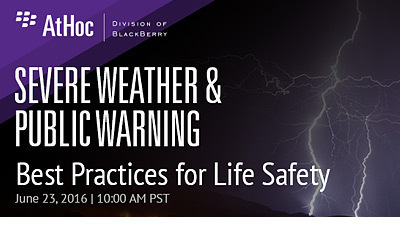 Severe Weather & Public Warning: Best Practices for Life Safety, is the name of the webinar AtHoc will be hosting this Thursday, June 23, with a presentation and open discussion on best practices for public warning when dangerous weather threatens life and property.
Severe Weather & Public Warning: Best Practices for Life Safety, is the name of the webinar AtHoc will be hosting this Thursday, June 23, with a presentation and open discussion on best practices for public warning when dangerous weather threatens life and property.
This blog was written by AtHoc’s Business Development Manager, John Linstrom.
We’ve got two great speakers lined up to help organizations be faster and more effective at delivering critical messages to an increasingly mobile population. It’s a great opportunity for emergency managers, community warning specialists, environmental health and safety managers, and business executives to learn how to better protect staff and surrounding.
Our first speaker is Randy Corbin, Fire Chief (ret.), Community 9-1-1 Consultant, Fusion Center Board Member, Urban Search & Rescue, and Incident Management Team member. Mr. Corbin will focus on crisis communications in the real world, based on his experiences as a senior responder at the World Trade Center after the attacks on 9/11, as well as multiple hurricanes in Texas and healthcare recovery in Haiti after that country’s devastating earthquakes.
Our other speaker is Efraim Petel, AtHoc’s Senior Director of Strategic initiatives. Mr. Petel is a renowned U.S. Homeland Security expert who helped develop the National Emergency Alert System and FEMA Integrated Public Alert & Warning System (IPAWS), as well as served on the board for Emergency Alert System Common Alerting Protocol (EAS-CAP). He brings a unique perspective to the challenge of severe weather, having worked on both the government and commercial side of crisis communications.
These experts will give you their perspective and guidance on:
- Severe weather incidents in North America. (U.S./Canada/Mexico)
- The evolution of public warning (public/private; indoor vs. outdoor; sirens, cable and radio broadcasts; smart TVs and mobile devices)
- How to implement IPAWS and Wireless Emergency Alerts (WEA) functionality
- Lessons learned about public warning based on real events
- The future of crisis communications
We want the “discussion” part of this event to be frank and open, and your participation is crucial to help make it a success.
It’s free, and we look forward to hearing from you on June 23.
This was originally published on the AtHoc blog.